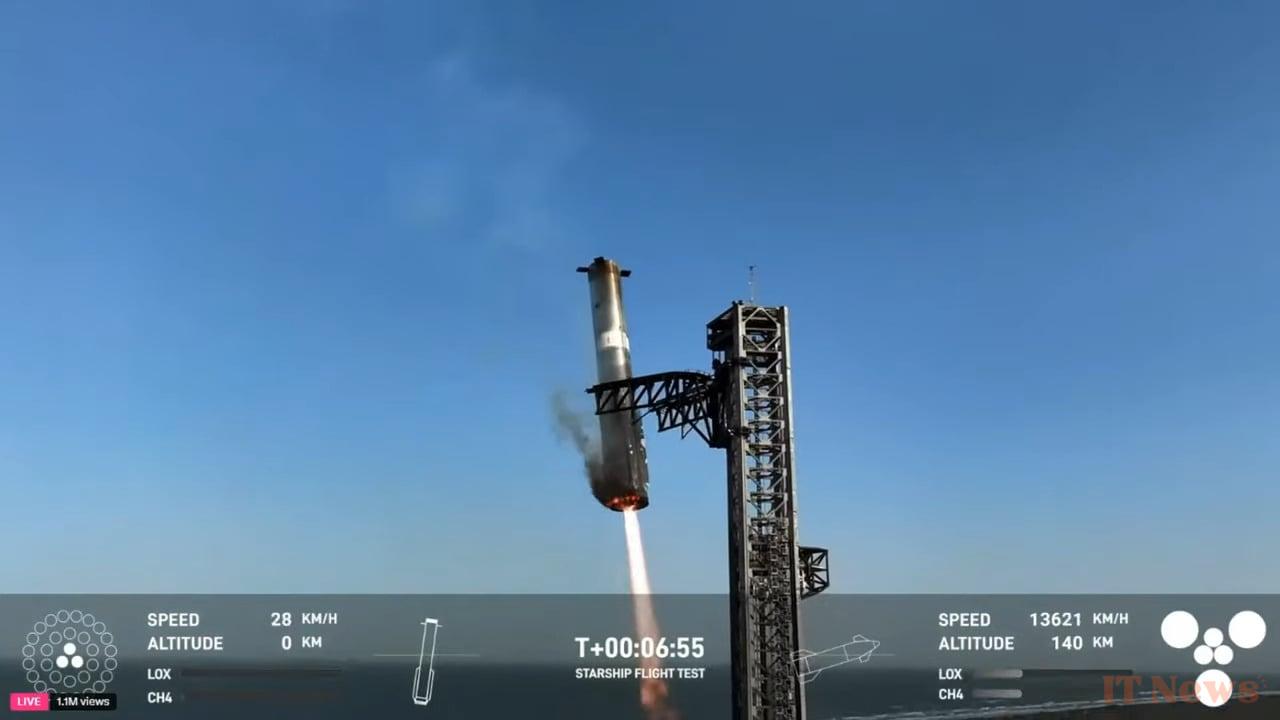On the night of March 6-7, SpaceX's huge Starship unfortunately encountered a critical malfunction during its eighth test flight. The incident led to the disintegration and loss of the vehicle, for the second consecutive time in the space of two months. A dynamic that is starting to become slightly worrying for Elon Musk's company.
The takeoff, shortly after midnight French time, had nevertheless gone very well. After a little over two minutes of thrust, the Super Heavy booster separated from the second stage without a problem, showing that the hot staging approach implemented last year is still working just as well.
The other great satisfaction of the evening concerns the return to Earth of this giant first stage (over 70 meters high on its own). At the end of the separation, it returned to the base where it was caught in mid-flight by the mechanical arms of its immense launch tower. This is the third time in a row that SpaceX has accomplished this technical feat.
A new failure of the propulsion system
So everything had started under the best auspices — but that was without counting on the Starship itself. About ten minutes after the ignition, just before the end of its first thrust phase, its ascent was abruptly stopped by the loss of several Raptor engines.
More specifically, these were central engines, which play a particularly important role in trajectory control. Unsurprisingly, the craft quickly began to tilt — a loss of control that first severed communications between the ship and the base, then led to its total destruction.
Still a vibration problem?
The scenario seems almost identical to the one that ended the 7th test flight, which also ended with a shower of incandescent debris.
On February 24, at the end of the investigation into the incident, the company concluded that the vehicle had experienced a “harmonic response” that was significantly stronger in flight than that observed during testing.
This term refers to the way in which the structure reacts to vibrations. Every object, whatever it is, has one (or more) so-called resonant frequencies. If an external force makes it vibrate at this frequency, it can lead to a resonance effect that amplifies the vibrations in a sometimes catastrophic way — a bit like a wine glass that shatters when exposed to a loud sound at this famous resonant frequency. In this case, it was the power lines of the propulsion system that paid the price.
SpaceX nevertheless believed that it had solved the problem by making a few changes to the structure of the propulsion system. It also added additional valves as well as a gas purge system to prevent the incident from happening again. But this latest failure suggests that the Starship's propulsion system is still not up to par.
For now, the company has not yet had time to determine whether this latest incident was also linked to the harmonic response. To be sure, we will have to wait until the end of the internal investigation required by the FAA — the American aeronautics regulator.
A diva who keeps herself desired
But in any case, this second consecutive failure is a serious setback for SpaceX. Engineers will have to roll up their sleeves to solve the problem once and for all.
Its Starship is highly anticipated, not only because it is to be the main player in the deployment of the next generation of Starlink satellites, but also because it is to play a central role in NASA's Artemis program. Without it, it will be impossible to transport astronauts to the Moon during the Artemis 3 and 4 missions, planned from 2027.
The company will therefore have to work extra hard to bring its revolutionary machine to maturity before these deadlines, which have already been pushed back several times.




0 Comments